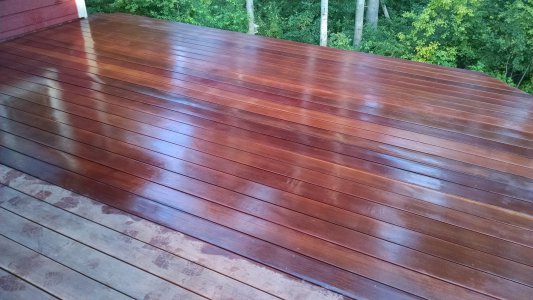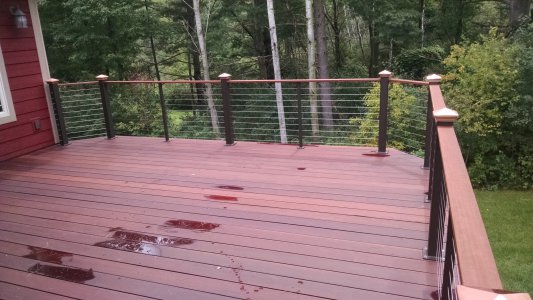I am a semi-retired cabinet maker who was the son of a foreman of a wood finishing shop for 35 years. I could write a book on the possibilities of your project,.. but to keep it simple. Oil finish on wood was a early traditional solution because oil and water don't mix, so you oil your wood project so it doesn't get wet and rot. Unfortunately, oils need to be maintained, so one year of the sun beating down on it and people walking on it means you are never done with the job. You're always going to maintain it by coating it again. At that point, some people think I'd rather just install it bare and let it die in 10 years, then I'll just replace it, because it truth, it will probably only last 15 years with all that maintenance anyway.
Oils with that build up a barrier coat like tung oil, varnish, or some of the modern chemical formulas try to get a little of both kinds of protection. They soak into the wood to keep the wood fibers from absorbing water, and they try to have some barrier coat properties so no surface fibers wet out from water. Again, these finishes take some maintenence, but probably every other year or every few years depending on how intense your summer sun and traffic frequency is.
Stuff like Ipe or teak, white oak, and locust are either naturally dense or have tylosis in their grain which keeps water from penetrating down the grain. Locust is notorious for being rotten on the skin of the outside of a board left in contact with the ground and have perfectly sound beautiful wood grain uneffected close to that rotten surface. it's a very rot resistant wood. It was traditionally burried for fence posts for the old split rail fences because the part in the ground just wouldn't rot beyond the surface touching dirt.
Some of the issues with these woods are:
locust is a somewhat twisty. so long straight lengths are hard to find, but you don't need that so it's viable for your project. It's hard as hell and can check much like an oak like grain so the checks can be like spear points, so I would radius all the edges if you use that. White oak is similar, but less dense, more ring porous and would need more frequent oiling. White oak is expensive and no lumber yard is going to have locust. Maybe some private mill would have it, but then you would have to plane it and it destroys cutting edges quickly.
Ipe and Teak and alike are cool rain forest type material. If you chose them go right out and buy all new blades for your planer and saws. They suck up silica from the ground as they grow and they destroy knives and blade sharpness pretty quickly. that being said, they are nice looking. With the ipe you might have to counter bore holes to screw it down because it's that hard. Nails can bounce off it like superman or just go in a bit and fold up like an accordian....
Personally, I've milled my own lumber for 40 years, and I'd use the cedar, knowing it was going to fail in 10 years, because it is easy to work with and soft to walk on without getting splinters unlike some of the others. Then I would oil it every year on the morning of a really hot day and it would be bulletproof the next day.... done.
Composite works too, but usually it isn't stiff enough to use 16" framing spans and requires 12" framing which may or may not be a problem for your existing frame. Composite doesn't nail well, so it has to be predrilled and screwed or screwed down with a clip system of some sort. It's functional, but ugly.....



